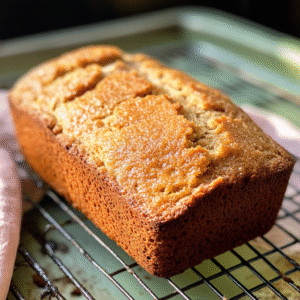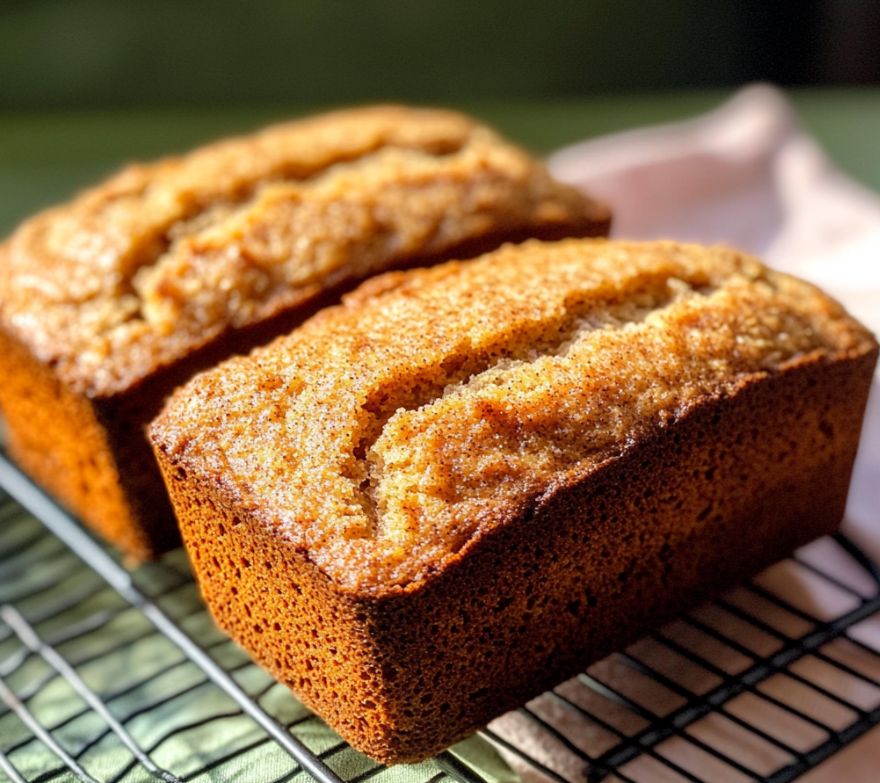My Journey to the Perfect Loaf
Eight years ago, my first attempt at cinnamon applesauce bread was a complete failure. Burnt edges, a gooey center, and flavor so off that my husband gently suggested ordering takeout instead. That kitchen disaster sparked an obsession—I was determined to master this deceptively simple recipe.
After hundreds of test batches and more than a few smoke alarms, I’ve finally cracked the code. This isn’t just another recipe to add to your collection; it’s the culmination of years of experimentation, packed with every lesson I learned the hard way.
Why This Bread Deserves Your Attention
Banana bread may dominate the quick bread world, but once you taste this cinnamon applesauce bread, you might crown a new champion. What makes it special? Pure versatility. Enjoy it warm with butter for breakfast, pair it with afternoon tea, or elevate it to dessert status with a scoop of vanilla ice cream. Plus, it fills your home with the most incredible fall-spice aroma—no matter the season.
What Sets This Recipe Apart
Most applesauce bread recipes fall into one of two traps: they’re either too dry and crumbly, or dense and gummy. This recipe achieves the ideal middle ground—wonderfully moist without being soggy, perfectly spiced without overwhelming your palate, and simple enough that even my teenager can successfully make it (though I can’t vouch for the state of the kitchen afterward).
The difference? A carefully calibrated ingredient ratio combined with some unconventional mixing techniques I’ll reveal below. These small adjustments deliver remarkable results.
Why You’ll Fall in Love With This Recipe
It’s Nearly Impossible to Mess Up
Even during my most hectic days—juggling algebra homework help, work emails, and dinner prep—this bread emerges from the oven perfectly. The forgiving recipe and harmonious ingredients consistently produce a moist, tender loaf.
It Relies on Pantry Staples
Nothing’s more disappointing than discovering a recipe requires a specialty ingredient that demands a store trip. This bread uses everyday essentials: flour, sugar, eggs, and applesauce. I always stock unsweetened applesauce (those single-serve cups work perfectly and double as lunchbox additions), making this my default choice when I need something homemade in a hurry.
The Science of Moisture
Let me share some baking chemistry I’ve picked up along the way. Applesauce plays two critical roles:
- It delivers moisture and natural sweetness without weighing down the texture
- It reduces oil or butter requirements, creating a lighter crumb while offering subtle health benefits
Additionally, the acid in applesauce reacts with baking soda, boosting rise and creating that coveted tender crumb. It’s an ingredient partnership that simply works.
The Recipe: Cinnamon Applesauce Bread
Ingredients You’ll Need
For the bread:
- 1½ cups all-purpose flour
- 1 teaspoon baking soda
- ½ teaspoon baking powder
- ½ teaspoon salt
- 1 teaspoon ground cinnamon (Saigon cinnamon provides stronger flavor)
- ½ teaspoon ground nutmeg (freshly grated preferred)
- ½ cup unsalted butter, softened
- 1 cup granulated sugar
- 2 large eggs, room temperature
- 1 cup unsweetened applesauce
- 1 teaspoon vanilla extract
Optional additions:
- ½ cup chopped walnuts or pecans
- ½ cup raisins or dried cranberries
- ¼ teaspoon ground cloves for deeper warmth

Perfectly moist cinnamon applesauce bread with a beautiful golden crust” RéessayerA
Step-by-Step Directions
1. Prepare Your Workspace
Heat your oven to 350°F and grease a 9×5-inch loaf pan thoroughly. I recommend lining the bottom with parchment paper—a game-changing trick I learned after ruining too many loaves during removal.
2. Combine Dry Ingredients
Whisk together flour, baking soda, baking powder, salt, cinnamon, and nutmeg in a medium bowl. Even distribution ensures consistent flavor and proper rise throughout the loaf.
3. Build the Foundation
Beat softened butter and sugar in a large bowl until light and fluffy—approximately 3 minutes with an electric mixer. Don’t cut this short! This step creates essential air pockets that help the bread rise beautifully.
4. Incorporate Eggs
Add eggs one at a time, ensuring each is completely mixed in before adding the next. If the mixture appears slightly curdled, don’t worry—it’ll come together when you add the flour.
5. Blend in Applesauce
Stir in applesauce and vanilla extract. The mixture may look somewhat separated, but this is perfectly normal.
6. Unite Wet and Dry Mixtures
Gradually fold the dry ingredients into the wet ingredients until just combined. Emphasis on “just”—overmixing develops gluten, resulting in tough, dense bread.
7. Fold in Extras (If Using)
Gently incorporate nuts, dried fruit, or additional spices with just a few light strokes.
8. Bake
Transfer batter to your prepared pan and smooth the top. Bake for 50-60 minutes, until a toothpick inserted in the center emerges with a few moist crumbs attached (not wet batter).
9. Cool Properly
Allow the bread to rest in the pan for exactly 10 minutes—set a timer. Then transfer to a wire rack and let cool completely before slicing. I know the wait is difficult, but the texture genuinely improves with patience.
Expert Tips for Success
Temperature Matters
Always bring eggs and butter to room temperature before starting. Cold ingredients don’t blend properly and can affect the final texture.
Don’t Overmix
Once you add the flour, mix only until you can’t see dry streaks. Overmixing creates a tough, dense loaf instead of the tender crumb we’re after.
Test for Doneness
A toothpick should come out with a few moist crumbs—not wet batter, but not completely clean either. This ensures a moist loaf without underbaking.
The Cooling Secret
That 10-minute rest in the pan isn’t arbitrary. It allows the bread to set just enough to release cleanly while still being warm enough to finish cooking slightly from residual heat.
Solving Common Problems
Bread Too Dry
Reduce baking time by 5 minutes, or add an extra 2 tablespoons of applesauce next time. Also check that you’re measuring flour correctly—spoon it into the cup rather than scooping.
Gummy Center
Your oven temperature may be inaccurate. Try increasing heat by 25 degrees or extending baking time by 5-7 minutes with foil loosely tented over the top to prevent over-browning.
Poor Rise
Verify your baking soda and baking powder are fresh. They lose effectiveness over time and should be replaced every 6-12 months. Also ensure you’re not skipping the creaming step—those air pockets are crucial.
Sunken Middle
This usually means the bread was underbaked or the oven door was opened too early. Wait at least 45 minutes before checking, and always use the toothpick test.
Storage and Freezing
Room Temperature: Wrap tightly in plastic wrap or store in an airtight container for up to 3 days.
Refrigerated: Store in an airtight container for up to one week. The bread may become slightly firmer, but toasting restores its texture beautifully.
Frozen: Slice the completely cooled loaf, wrap each slice individually in plastic wrap, and place in a freezer bag. Freeze for up to 3 months. Thaw individual slices at room temperature or toast directly from frozen.
Perfect Serving Suggestions
- Classic: Toasted with a thin cream cheese spread
- Decadent: Warm with vanilla ice cream and caramel drizzle
- Cozy: Alongside a steaming mug of apple cider on cool evenings
- Brunch-Worthy: As part of a spread with fresh fruit and yogurt
- Kid-Approved: Plain or with a light dusting of cinnamon sugar on top
Frequently Asked Questions
Can I use sweetened applesauce instead of unsweetened?
Yes, but reduce the sugar to ¾ cup to compensate for the extra sweetness in the applesauce.
Can I make this without eggs?
Replace each egg with a “flax egg” (1 tablespoon ground flaxseed mixed with 3 tablespoons water, left to sit for 5 minutes). The texture will be slightly denser but still delicious.
What if I don’t have nutmeg?
You can omit it or substitute with extra cinnamon, allspice, or a pinch of ground ginger.
Can I make muffins instead of a loaf?
Absolutely! Fill muffin cups two-thirds full and bake at 350°F for 18-22 minutes. This recipe makes approximately 12 muffins.
My bread cracked on top—is that okay?
Yes! That characteristic crack is completely normal for quick breads and doesn’t affect taste or texture.
Can I reduce the sugar?
You can reduce it to ¾ cup, but going lower may affect both moisture and texture. The applesauce provides some natural sweetness, but sugar also helps retain moisture.
Do I need to peel my apples if making homemade applesauce?
For this recipe, store-bought unsweetened applesauce works perfectly. If making your own, peeling creates a smoother texture, but leaving peels on adds fiber and nutrients.
Can I add chocolate chips?
Definitely! Fold in ½ to ¾ cup of chocolate chips with the optional add-ins. They pair surprisingly well with the cinnamon.
Final Thoughts
After years of refinement, I’m confident this represents the finest cinnamon applesauce bread recipe available. It balances simplicity with sophistication—straightforward enough for everyday baking yet impressive enough for gifting or entertaining.
The beauty of this recipe lies not just in its delicious results, but in its reliability. Whether you’re a seasoned baker or just starting out, this bread will deliver that perfect combination of moist texture, warm spices, and comforting aroma that makes homemade baking so rewarding.
Next time you spot applesauce in your pantry and crave something homemade, give this recipe a try. I’d love to hear your results and any creative variations you discover. Happy baking!
